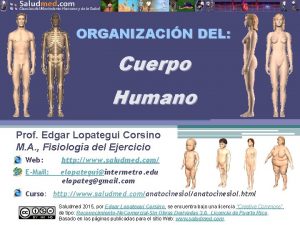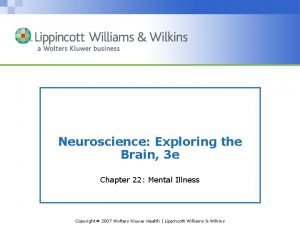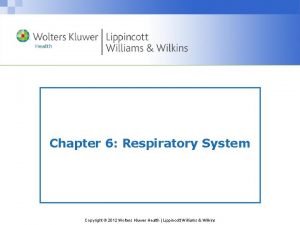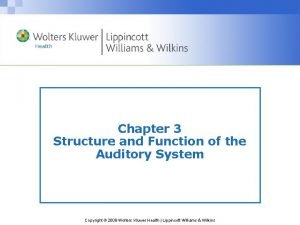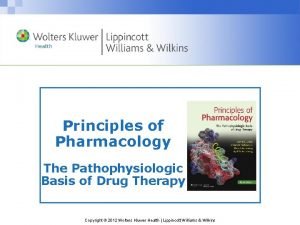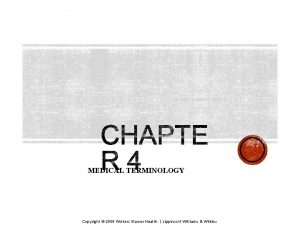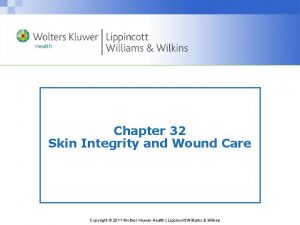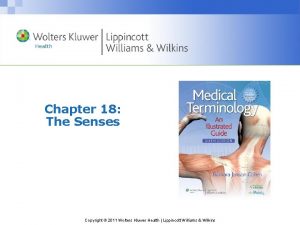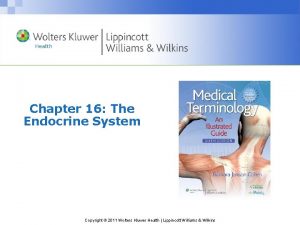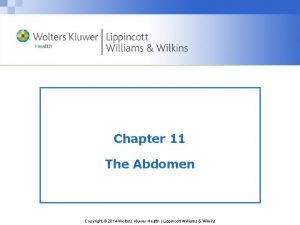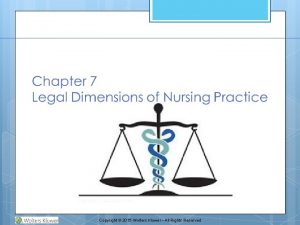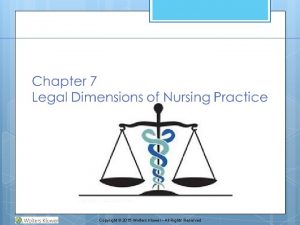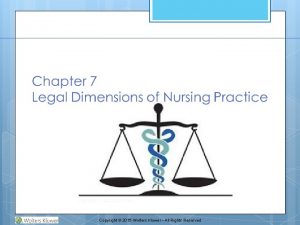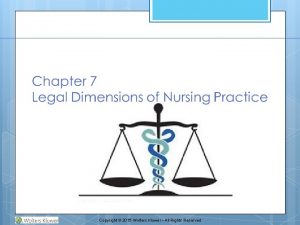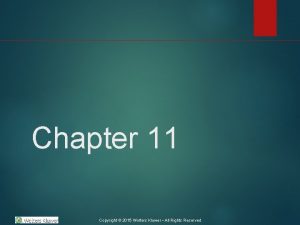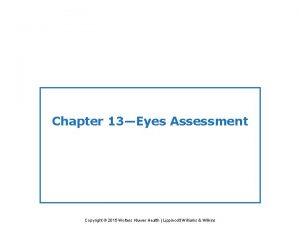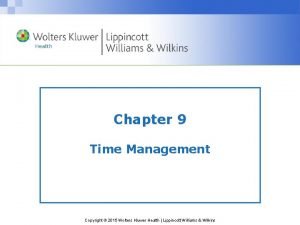Copyright 2015 Wolters Kluwer All Rights Reserved Nurses

























- Slides: 25

Copyright © 2015 Wolters Kluwer • All Rights Reserved

Ø Nurses who wish to avoid legal conflicts need to develop trusting patient relationships (satisfied patients rarely sue) Ø Practice within the scope of their license Ø Identify potential liabilities in their practice and work to prevent them. Copyright © 2015 Wolters Kluwer • All Rights Reserved

Definition of Law Standard or rule of conduct established and enforced by the government Designed to protect the rights of the public Copyright © 2015 Wolters Kluwer • All Rights Reserved

Law Terminology Litigation: process of bringing and trying a lawsuit Plaintiff: person bringing suit Defendant: person being accused of a crime Presumed innocent until proven guilty Copyright © 2015 Wolters Kluwer • All Rights Reserved

Types of Laws Public law —government is directly involved Regulates relationships between individuals and government Private law —civil law Regulates relationships among people Criminal law —concerns state and federal criminal statutes Defines criminal actions (e. g. , murder, theft) Copyright © 2015 Wolters Kluwer • All Rights Reserved

Four Sources of Law Constitutions: serve as guides to legislative bodies Statutory law: enacted by a legislative body Ex. Nurse Practice Act Administrative law: empowered by executive officers Ex. Board of Nursing Common law: judiciary system reconciles controversies, creates body of common law Copyright © 2015 Wolters Kluwer • All Rights Reserved

Professional and Legal Regulation of Nursing Practice Ø Nurse o practice acts Scope of practice and legal regulations by state Ø Nursing o o Standards Voluntary standards- developed and implemented by the nursing profession itself, not mandatory but are used as standards for peer review; ex. American Nurses Association (ANA) Legal standards- developed by legislature; ex. Nurse Practice Acts Copyright © 2015 Wolters Kluwer • All Rights Reserved

Professional and Legal Regulation of Nursing Practice Credentialing - ways in which professional competence is ensured and maintained. Accreditation- process by which an educational program is evaluated and recognized as having met certain standards. National accreditation is voluntary, state is a legal requirement Copyright © 2015 Wolters Kluwer • All Rights Reserved

Reasons for Suspending or Revoking a License Ø Drug or alcohol abuse (most frequent reason) Ø Fraud Ø Deceptive practice Ø Criminal acts Ø Previous disciplinary actions Ø Gross or ordinary negligence Ø Physical or mental impairments, including age Copyright © 2015 Wolters Kluwer • All Rights Reserved

Due Cause for Revoking a License The person being accused is considered innocent until proven guilty. Ø Notice Ø Fair of investigation and impartial hearing Ø Proper decision based on substantial evidence Copyright © 2015 Wolters Kluwer • All Rights Reserved

Nurse’s Best Defense of License Investigation Early legal counseling Character and expert witnesses Thorough preparation for all proceedings Copyright © 2015 Wolters Kluwer • All Rights Reserved

Criminal Law Crime: wrong against a person or the person’s property as well as the public- punishable by the state ex. Rape, murder Misdemeanor: punishable by fines or less than 1 year imprisonment Felony: punishable by imprisonment for more than 1 year Tort: a wrong committed by a person against another person or that person’s property; tried in civil court Intentional Unintentional Copyright © 2015 Wolters Kluwer • All Rights Reserved

Intentional and Unintentional Torts Intentional Assault and battery (know the difference) Defamation of character Invasion of privacy (HIPPA) False imprisonment Fraud Assault: verbal threats Battery: I take a bat to your head Copyright © 2015 Wolters Kluwer • All Rights Reserved

Intentional and Unintentional Torts Unintentional Negligence: performing an act -or- failing to perform an act that a nurse under similar circumstances would do/not do Malpractice: the term used to describe negligence by a professional personnel Copyright © 2015 Wolters Kluwer • All Rights Reserved

HIPAA-Ensured Patient Rights ü To see and copy their health record ü To update their health record (not change it) ü To request correction of any mistakes ü To get a list of the disclosures a health care institution has made independent of disclosures made for the purposes of treatment, payment, and health care operations ü To request a restriction on certain uses or disclosures ü To choose how to receive health information Copyright © 2015 Wolters Kluwer • All Rights Reserved

Four Elements of Liability All 4 elements must be present to prove malpractice Ø Duty-obligation to use due care Ø Breach of duty- failure to meet standard of care Ø Causation- failure to meet the standard of care actually caused injury Ø Damages- patient actual harm or injury resulting to the Copyright © 2015 Wolters Kluwer • All Rights Reserved

Three Outcomes of Malpractice Litigation 1) All parties work toward fair settlement. 2) Case is presented to malpractice arbitration panel. 3) Case is brought to trial court. Copyright © 2015 Wolters Kluwer • All Rights Reserved

Roles of Nurses in Legal Proceedings ØNurse as defendant ØNurse as fact witness ØNurse as expert witness Copyright © 2015 Wolters Kluwer • All Rights Reserved

Recommendations for Nurse Defendant ü Do not discuss the case with those involved in it. ü Do not alter patient records. ü Cooperate fully with your attorney. ü Be courteous on witness stand. ü Do not volunteer any information. Copyright © 2015 Wolters Kluwer • All Rights Reserved

Legal Safeguards for Nurses Ø Competent practice Ø Informed consent or refusal review p. 123 -125 Ø Contracts Ø Collective bargaining Ø Patient education- DOCUMENT!! Ø Executing physician orders Ø Documentation Ø If you didn’t document it, it DIDN’T happen!! Copyright © 2015 Wolters Kluwer • All Rights Reserved

Legal Safeguards for Nurses (cont. ) Ø Adequate staffing Ø Whistle-blowing Ø Professional liability insurance Ø Risk management programs Ø Incident, variance, or occurrence reports Ø Sentinel events and Never events Ø Patients’ rights Ø Good Samaritan Laws Look over these in your bookpgs. 123 -131 Copyright © 2015 Wolters Kluwer • All Rights Reserved

Types of Risk Management Programs Safety program: provide basic safety needs and a safe environment for patients, staff and visitors Products safety program: ensures safe and adequate equipment Quality assurance program: provide quality health care to patients, ongoing evaluation of all systems used in the care of patients Copyright © 2015 Wolters Kluwer • All Rights Reserved

Information Contained in Incident Reports ü Complete name of person and names of witnesses ü Factual account of incident ü Date, time, and place of incident ü Pertinent characteristics of person involved ü Any equipment or resources being used ü Any other important variables ü Documentation by physician of medical examination of person involved Copyright © 2015 Wolters Kluwer • All Rights Reserved

OSHA Legal Regulations Occupational Safety and Health Act sets legal standards in the U. S. in effort to ensure safe and healthful working conditions for men and womenintended to reduce work-related injuries and illness. v Use of electrical equipment v Use of isolation techniques v Use of radiation v Use of chemicals Copyright © 2015 Wolters Kluwer • All Rights Reserved

Student Liability Responsible for your own acts of negligence if these result in patient injury. Held to same standard of registered nurse. Student has duty to notify nursing instructor if student feels in any way unprepared for nursing procedure. Hospital, nursing instructor and school may also be held liable! Copyright © 2015 Wolters Kluwer • All Rights Reserved
 Copyright 2015 all rights reserved
Copyright 2015 all rights reserved Copyright © 2015 all rights reserved
Copyright © 2015 all rights reserved Dell all rights reserved copyright 2009
Dell all rights reserved copyright 2009 Copyright © 2018 all rights reserved
Copyright © 2018 all rights reserved Wolters kluwer health
Wolters kluwer health Wolters kluwer health
Wolters kluwer health Wolters kluwer
Wolters kluwer Wolters kluwer
Wolters kluwer Wolters kluwer
Wolters kluwer Chemical synapse
Chemical synapse Wolters kluwer health
Wolters kluwer health Exercise physiology for health, fitness, and performance
Exercise physiology for health, fitness, and performance Wolters kluwer
Wolters kluwer Wolters kluwer health
Wolters kluwer health Wolters kluwer health
Wolters kluwer health Wolters kluwer
Wolters kluwer Wolters kluwer health
Wolters kluwer health Wolters kluwer health
Wolters kluwer health Virchow's triad
Virchow's triad Wolters kluwer pronunciation
Wolters kluwer pronunciation Wolters kluwer
Wolters kluwer Chapter 48 skin integrity and wound care
Chapter 48 skin integrity and wound care Wolters kluwer
Wolters kluwer Wolters kluwer
Wolters kluwer Wolters kluwer
Wolters kluwer Wolters kluwer ovid
Wolters kluwer ovid






